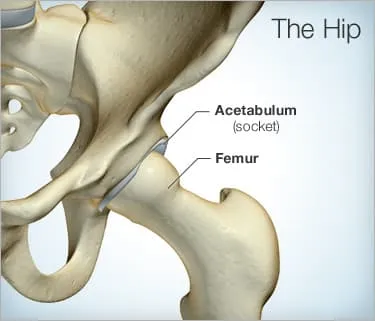Your hip is the joint where your thigh bone meets your pelvis. It is called a ball-and-socket joint, because the ball-like top of your thigh bone fits into a cup-like area within your pelvis, much like a baseball fits into a glove.

Normally, the ball glides smoothly within the socket, but a problem with the ball or socket rim can interfere with smooth motion, leading to hip impingement or femoro acetabular impingement (FAI). It is believed to be a major cause of early osteoarthritis of the hip, particularly in those under age 40.
Hip Impingement Symptoms
You can have hip impingement for years and not know it, because it is often not painful in its early stages.
When hip impingement causes symptoms, it may be referred to as hip impingement syndrome. The main symptoms are "pain" in the groin, especially when walking or flexing the hip, and decreased range of motion in the hip.
At first, you may only feel pain when you move the hip near its limits. As the condition progresses, however, you may feel pain with more subtle activities, such as sitting for a long time or walking up a hill. Pain that occurs at night or when walking on flat ground suggests that the cartilage cushioning the ball and socket has begun to break down and wear away, a condition known as osteoarthritis.
Hip Impingement Causes
There are two main causes of hip impingement:
A deformity of the ball at the top of the femur (called cam impingement). If the head is not shaped normally, the abnormal part of the head can jam in the socket when the hip is bent. This may occur during activities such as riding a bicycle or tying your shoes.
A deformity of the socket (pincer impingement). If the front rim of the socket (called the acetabulum) sticks out too far, the area of the thigh bone (femur) just below the ball, called the neck of the femur, may bump into the rim of the socket during normal hip flexion movement.
In some cases, there is a problem with both the ball and the socket. Other problems that can cause hip impingement include conditions such as:
- Legg-Calve-Perthes disease, a disease in which the ball part of the hip joint doesn't get enough blood, which causes the bone to die.
- Slipped capital femoral epiphysis, a separation of the ball from the thigh bone at the upper growing end (growth plate) of the bone in adolescents. It is more common in children who are obese.
- Coxa vara, an unusual condition in which the thigh bone and ball do not grow at the same pace in children. This discrepancy leads to deformity of the hip joint.
Hip Impingement Tests and Diagnosis
If you have symptoms of hip impingement, your doctor can diagnose the problem based on your description of your symptoms, a physical exam, and the findings of imaging tests. These tests may include one or more of the following:
- X-ray, a test that produces images of internal structures on film. X-rays can show irregularities in the shape of the ball or top of the thigh bone or excess bone around the rim of the socket.
- Magnetic resonance imaging (MRI), a procedure that uses large magnets, radio waves, and a computer to produce detailed pictures of tissues inside the body. An MRI can show fraying or tears of the cartilage, including that which runs along the rim of the socket (labrum).
- CT scan, a technique that combines special X-ray equipment with sophisticated computers to produce multiple images or pictures of the inside of the body. These images can be examined on a computer, printed, or transferred to a CD. A CT or MRI scan can help a doctor decide whether you need surgery.
Hip Impingement Treatments
Treatment for hip impingement should begin with:
- Resting the affected hip
- Modifying your activities to avoid moving the joint in a way that causes pain
- Exercising as recommended by your doctor or physical therapist to strengthen the muscles that support the hip
- Physical therapists who specialize in the hip or recovery of hip injuries can do a lot to help strenghten muscles around the hip and relieve inflammation.
- Taking anti-inflammatory and pain medications
If these treatments do not relieve pain, your doctor may recommend hip impingement surgery.
The type of surgery needed will depend on the problem causing hip impingement and how much cartilage damage has occurred.
Often, surgery for hip impingement can be performed arthroscopically. This technique involves inserting a lighted scope and thin tools through small incisions over your hip instead of making a large incision. Arthroscopy is usually an outpatient surgery. This means you can go home the same day.
The earlier you have surgery, the greater your chances of a complete recovery. But even if cartilage has been damaged, surgery may still reduce pain and improve range of motion.
If cartilage damage is severe, however, hip replacement may be the only treatment that will relieve pain and improve function.
However, there are promising experimental treatments, including one in which parts of your own blood are injected into joints to stimulate cartilage growth.

